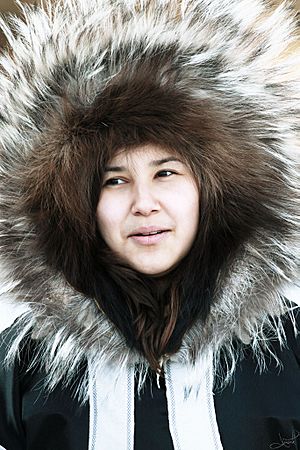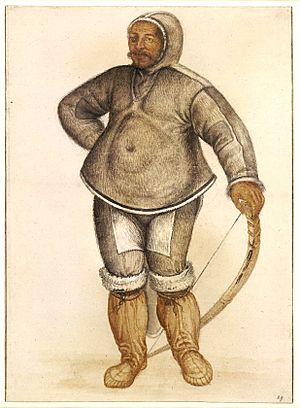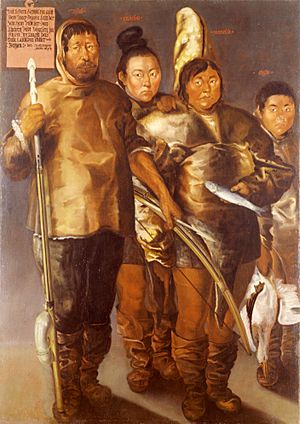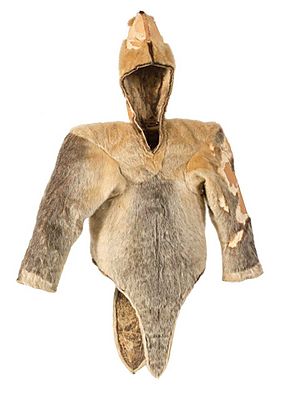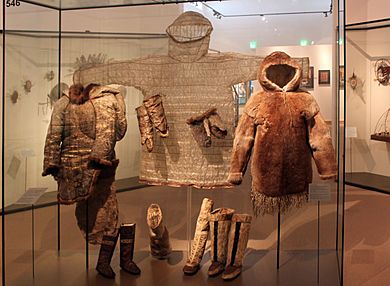Research on Inuit clothing facts for kids
For a long time, people have been very interested in Inuit clothing. Since Europeans first met the Inuit people in the 1500s, there has been a lot of study about their amazing clothes. This includes drawings, books, scientific tests, and museum collections.
In the past, Europeans learned about Inuit clothing in a few ways. They saw clothes worn by Inuit people who traveled to Europe. Sometimes, explorers brought clothing back to museums. They also read stories written by people who traveled to the Arctic.
From the 1700s to the mid-1900s, explorers, missionaries, and scholars wrote a lot about Inuit clothing. After a quiet period in the 1940s, serious studies started again in the 1980s. This time, researchers focused on specific Inuit groups and worked closely with Inuit communities. Scientists often studied how well Inuit skin clothing kept people warm in the cold. Many museums, especially in Canada, Denmark, the United Kingdom, and the United States, have large collections of old Inuit clothes. These were often collected during Arctic trips in the 1800s and early 1900s.
Contents
How We See Inuit Clothing
Inuit skin clothing has always fascinated artists and thinkers. Europeans started drawing Inuit clothing as early as the 1500s. These pictures often came from Inuit people who visited Europe, clothes brought back by explorers, or travel stories.
One of the first examples was a series of printed pictures from 1566. These were made after an Inuit mother and child from Labrador were brought to Europe. In 1577, an explorer named Martin Frobisher brought three Inuit people – Kalicho, Arnaq, and Nutaaq – to England. A painter named John White drew detailed watercolor pictures of them.
A painting from 1654, made in Bergen, Norway, is the oldest known picture of traditional clothing from the Kalaallit people of Greenland. It shows four Kalaallit people who were taken by a Danish ship. They are all wearing their traditional skin clothes. Many other paintings and drawings of Inuit and their clothing were made in Europe over the next few centuries.
Later, new ways of printing like lithography and photography became popular in the mid-1800s. This made it easier to share pictures of Inuit clothing, especially in magazines. Around 1860, some Danish books about Inuit culture and clothing from Greenland included pictures made by Inuit artists.
Big trips like the Canadian Arctic Expedition (1913–1916) and the Fifth Thule Expedition (1922–1924) brought cameras and photographers to the Arctic. They took many pictures of Inuit people and their clothes. These groups tried to be respectful. However, not all photographers at that time were. Many early 1900s photos of Inuit don't name the people in them. Also, some Inuit in these photos look uncomfortable.
Learning About Inuit Clothing
One of the oldest important books about Inuit clothing is from 1741. It was written by a Danish missionary named Hans Egede. He lived in Greenland for 15 years. His book had detailed drawings and descriptions of women's clothing.
Starting in the 1700s, explorers and traders wrote diaries and other stories. These gave more details about everyday Inuit clothing. As more outsiders met Inuit people, the writings became even more detailed. The clothing of the Caribou Inuit and Copper Inuit from this time is very well described in these writings.
In the 1800s and early 1900s, scholars from Denmark, America, and Canada studied Inuit culture and clothing. They focused on how Inuit clothing helped people survive in the very cold Arctic. They also looked at how the clothes were made. People who study cultures, called ethnographers, like John Murdoch, published detailed drawings and descriptions of Inuit clothing in 1892. He based his work on what he saw in northwest Alaska.
Canadian explorers Diamond Jenness and Vilhjalmur Stefansson lived with the Inuit during the Canadian Arctic Expedition (1913–1916). They wore Inuit clothing and studied how it was made in great detail. Jenness also collected many clothes for the Canadian Museum of Civilization.
A Danish archaeologist named Gudmund Hatt wrote a paper in 1914. It was about his ideas on where the Inuit came from. He based it on his deep study of Inuit clothing in museums across Europe. Later, other scholars disagreed with his ideas about migration. But his studies of Inuit clothing, with beautiful drawings by his wife Emilie Demant Hatt, were very detailed and important. Around 1940, serious studies of Arctic clothing slowed down.
Studies of Inuit clothing started up again in the 1980s and 1990s. This began with fieldwork by an expert named Bernadette Driscoll-Engelstad. She also used information from northern seamstresses. By then, the old way of studying many cultures at once, like Hatt did, was less popular. Modern scholars preferred to study the clothing of specific Inuit groups in depth. From the 1970s to 1990s, researchers Jill E. Oakes and Rick Riewe from the University of Manitoba traveled across the Arctic. They recorded information about the traditional footwear of people living around the North Pole.
Around this time, scholars started working with Inuit communities. These partnerships became very important for keeping traditional knowledge alive. For example, the Igloolik Research Centre in Nunavut, Canada, records interviews with Inuit elders. This helps save their traditional knowledge, including how to make traditional clothing.
In the 1980s, Driscoll-Engelstad visited museums in Europe and Canada with Inuit seamstresses. They studied old clothes together. Their work helped bring back clothing making in some Canadian communities. At the same time, an Arctic expert named Susan Kaplan started working with Inuit people from North Greenland and Labrador. They did similar fieldwork at the Peary–MacMillan Arctic Museum. In 1992, Inuit seamstresses went to the Canadian Museum of Civilization. They studied how Copper Inuit clothes there were made. A documentary film called Piqutingit: What Belongs to Inuit came out in 2006. It shows a group of Inuit elders traveling to museums in different cities to study Inuit items, including clothing.
Science and Inuit Clothing
Discoveries from the Past
Archaeology is a big way we learn about the history of Inuit clothing. Archaeologists find tools used for preparing animal skins and sewing. Sometimes, they even find pieces of frozen skin clothes or whole outfits! Some of these items are from the older Dorset culture, but most are from the Thule culture (around 1000 to 1600 CE). Studies of these old clothes show that Inuit skin clothing has been made in similar ways for a very long time.
One of the most amazing finds was in 1972. A group of eight very well-preserved mummies were discovered at Qilakitsoq in Greenland. They were still wearing their clothes! The outer clothes were made from sealskin. The inner parkas were made from the skins of at least five different types of water birds. Scientists used carbon dating to find out the mummies are from about 1475. Tests showed that the skin clothes were made and sewn just like modern skin clothing from the Kalaallit people in that area. Studying the mummies' teeth and the sealskin clothes showed that the ways of preparing skins haven't changed much in 500 years. This includes using teeth to soften the skin for sewing.
Archaeological digs in Utqiaġvik, Alaska from 1981 to 1983 found the oldest known examples of caribou and polar bear skin clothing from the Kakligmiut people. These are from about 1510. How these clothes were made shows that Kakligmiut garments changed very little between about 1500 and 1850.
How Sewing Helps Communities
A report in 2020 looked at how sewing clothes helps modern Inuit communities. It was based on talking to 30 Inuit women in Ulukhaktok, Northwest Territories. The report found that taking part in traditional sewing was good for the seamstresses. It helped them spend time with others, feel connected to their culture, and even earn more money.
Another study in 2021 showed that group sewing sessions were a good way for Inuit women to share their knowledge. When sewing was part of the research, it helped balance the power between the women (who were the experts) and the researchers (who weren't experienced sewers). This made the women more comfortable sharing information.
Inuit Clothing in Museums
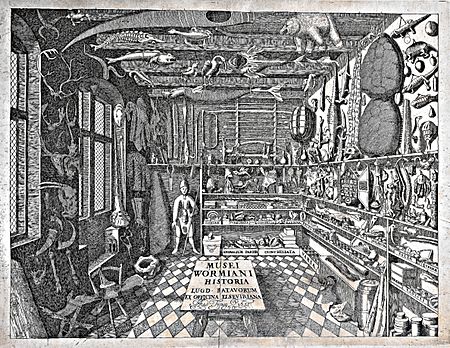
Many museums, especially in Canada, Denmark, the United Kingdom, and the United States, have huge collections of old Inuit clothes. The special dance clothing of the Copper Inuit is very common in museums around the world.
The British Museum in London has some of the oldest Inuit fur clothing still existing. It was collected by Captain William Edward Parry in Igloolik in the early 1820s. The Smithsonian Institution in Washington, D.C. has a large collection of Arctic items from Canada and Alaska, including clothing. They started collecting in 1850. A Norwegian explorer named Roald Amundsen collected many Inuit items, including clothing, during his trip through the Northwest Passage from 1903–1906. He brought them to the Ethnographic Museum of Norway (now the Museum of Cultural History, Oslo).
Museums in Denmark started collecting Inuit clothing early. In the 1620s, a Danish scientist named Ole Worm collected samples of Greenlandic Inuit clothing for his special collection, the "Museum Wormianum." Even though much of his collection later went to the National Museum of Denmark, the clothes he collected are now lost.
The National Museum of Denmark has one of the biggest collections of skin clothing in the world. It has over 2100 old skin clothing items from different Arctic cultures, with some as old as 1830. A museum expert named Christian Jürgensen Thomsen worked hard to make this collection bigger in the 1840s. In 1851, a Finnish ethnographer named Henrik Johan Holmberg collected hundreds of items, including skin clothes, from the Alaskan Inuit. Thomsen bought these for the Danish National Museum in 1852. Big trips like the Gjøa Expedition (1903–1906) and the Fifth Thule Expedition (1921–1924) brought back and gave over 800 North American Inuit clothes to the museum.
Even with these large collections, many museums rarely showed Inuit clothing and items during the 1900s. In North America, this only started to change in the 1980s with new exhibitions. In 1980, the Winnipeg Art Gallery had an exhibit called The Inuit Amautik: I like my hood to be full. It focused on the women's parka, the amauti. In 2020, another exhibit called Inuk Style showed both old and new Inuit fashion. In 1982, the Smithsonian Museum had a big exhibit of Inuit items and clothing called Inua: Spirit World of the Bering Sea Eskimo.
In 1994, the Canadian Museum of Civilization, which has the largest collection of Inuit clothing in North America, showed examples of clothing by the Inuit, Dene, and Nlaka'pamux First Nations. This exhibit, called Threads of the Land, was made with the help of Inuit seamstresses. Since 2016, the Bata Shoe Museum has a long-term exhibit called Art & Innovation: Traditional Arctic Footwear. It includes Inuit items collected by Jill Oakes and Rick Riewe from the 1970s to 1990s.
It's hard to keep skin clothing safe, even in a museum. The natural materials can decay, lose hair, or get bugs if not cared for very well. In the past, clothes were often shown without any protection. Storage areas were often dusty and full of insects. These poor methods caused many items to get damaged or even lost. Since the 1960s, ways to store cultural items have become much better. Today, skin clothes are usually kept in cold storage when not on display. When they are in the museum, they are in sealed cases with controlled temperature and light. While protection is important, research shows that how the clothes were first made and used also affects how much they decay.
Driscoll-Engelstad suggested that museums should work with Inuit artists to fix damaged clothes and items. What we've learned from keeping Inuit skin clothes safe has also helped protect other important historical documents. This includes the Royal Charter of the Hudson's Bay Company and the United States Declaration of Independence.
It's now easier for museum curators to work with Inuit communities. This is thanks to more travel and digital tools like the internet. Museums can provide materials for cultural programs or arrange training. This helps community members record traditional knowledge passed down by word of mouth. Many museums have also created online exhibits to make their collections easier to see. Projects like Skin Clothing Online, from the National Museum of Denmark, Greenland National Museum, and Museum of Cultural History, Oslo, have made thousands of high-quality pictures and many 3D scans of Arctic skin clothing available for everyone to see.
Images for kids


